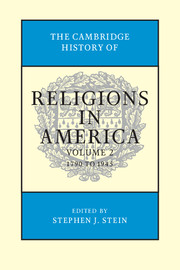Book contents
- Frontmatter
- Contents
- Contributors
- Editor's Introduction
- SECTION I RELIGION IN NORTH AMERICA
- SECTION II RELIGIONS IN THE NEW NATION, 1790–1865
- 5 Religious Organization in the New Nation
- 6 Religious and Geographical Expansion, 1790–1865
- 7 Theological Controversies, 1790–1865
- 8 Religion and Conflict from Independence to the Civil War
- 9 African Americans and the Making of Evangelical Christianities, 1760–1860
- 10 Religion and the Civil War
- SECTION III CHANGING RELIGIOUS REALITIES
- SECTION IV RELIGIOUS RESPONSES TO MODERN LIFE AND THOUGHT
- SECTION V COMPARATIVE ESSAYS
- SECTION VI RELIGION AND DIVERSE AREAS
- Index
- References
6 - Religious and Geographical Expansion, 1790–1865
from SECTION II - RELIGIONS IN THE NEW NATION, 1790–1865
Published online by Cambridge University Press: 28 July 2012
- Frontmatter
- Contents
- Contributors
- Editor's Introduction
- SECTION I RELIGION IN NORTH AMERICA
- SECTION II RELIGIONS IN THE NEW NATION, 1790–1865
- 5 Religious Organization in the New Nation
- 6 Religious and Geographical Expansion, 1790–1865
- 7 Theological Controversies, 1790–1865
- 8 Religion and Conflict from Independence to the Civil War
- 9 African Americans and the Making of Evangelical Christianities, 1760–1860
- 10 Religion and the Civil War
- SECTION III CHANGING RELIGIOUS REALITIES
- SECTION IV RELIGIOUS RESPONSES TO MODERN LIFE AND THOUGHT
- SECTION V COMPARATIVE ESSAYS
- SECTION VI RELIGION AND DIVERSE AREAS
- Index
- References
Summary
The religious complexion of the United States changed spectacularly in the two and one-half generations between the Revolutionary and Civil Wars. These changes were wrought, above all, by the conquest of the West, by the unleashing of populist forces, by the rise of new religious groups spawned by the country's political freedoms and geographical expanse, and by immigration. At the end of the era, groundwork had been laid for what was emerging as the most religiously complex nation in history.
GEOGRAPHICAL EXPANSION
Grants of land from Europe's powers to the original American colonists were conceived on a heroic scale. In 1620, for example, the Council for New England secured from King James a new charter granting it all the territory between 40° and 48° north latitude, “from sea to sea.” As with other charters, this extreme reach to unexplored lands in the West has struck modern observers as outrageous, avaricious, grandiose, humorous, or simply naïve. In their own time the reach seemed, to most of the land's inhabitants, remote and unfathomable. Unfathomable, that is, until American independence revolutionized not only the political, but also the geographical consciousness of those inhabitants, thereby unleashing new forces. Even then, the continental space to fill seemed infinite.
No sooner had the newly formed United States wrested free of Britain than it quickly acquired the heart of the remainder of the habitable continent.
- Type
- Chapter
- Information
- The Cambridge History of Religions in America , pp. 117 - 136Publisher: Cambridge University PressPrint publication year: 2000



